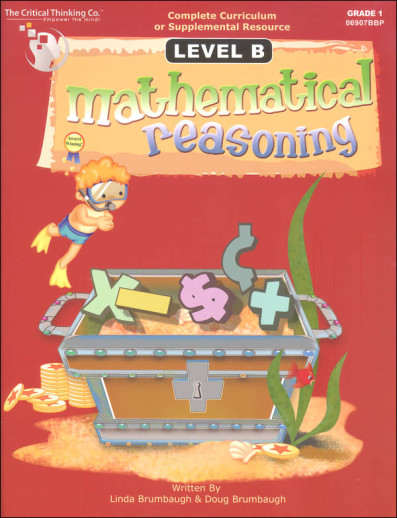We use cookies to make your experience better. To comply with the new e-Privacy directive, we need to ask for your consent to set the cookies. Learn more.
Mathematical Reasoning Level B (Gr. 1)
Forget boring math lessons and dreaded drill sheets. This fun, colorful 352-page book uses engaging lessons with easy-to-follow explanations, examples, and charts to make first grade mathematical concepts easy to understand. It can be used as a textbook or a comprehensive workbook with your textbook to teach the math skills and concepts that students are expected to know in first grade—and several concepts normally taught in second grade. This book emphasizes problem-solving and computation to build for success in higher-level math and math assessments.Every lesson is followed with a variety of fun, colorful activities to ensure concept mastery. The lessons and activities spiral slowly, allowing students to become comfortable with concepts, but also challenging them to continue building their problem-solving skills. This book teaches more than mathematical concepts; it teaches mathematical reasoning, so students learn to devise different strategies to solve a wide variety of math problems. It is written to the standards of the National Council of Teachers of Mathematics.
CONTENTS
At such an early age, mathematical reasoning begins with simple activities such as distinguishing between even or odd amounts and learning the ordinal numbers. This series is correlated to the NCTM standards and accordingly incorporates topics such as patterns, number concepts/number lines, graphs, fractions, probability, geometry, and problem solving, as well as basic operations. The full color activity sheets should especially appeal to the younger student. Not only are the illustrations eye-catching, but they do an excellent job of demonstrating mathematical representations and relationships. Although manipulatives are not required, a link to a virtual manipulative website is provided in case additional concrete level reinforcement is needed. A wide variety of exercises and activities are utilized to keep your child both interested and motivated. For instance, Thinker Doodles and Mind Benders activities from parent company Critical Thinking are scattered throughout.
Beginning 1 focuses on numbers 1-5 while Beginning 2 focuses on 0-10, and they are intended for use with 3 and 4 year olds. The concepts are presented in a spiral fashion, so students will see the concept repeated at different intervals throughout the book. In most cases, children who finish these first two books should be ready to tackle kindergarten math.
Books A through F are for grades kindergarten through 5th grade, and can be used as core math curriculum. We also like to recommend them as a critical thinking supplement for any math program that is light in that particular area. These books incorporate the same spiral approach found in the Beginning books. Level G has been added for 6th grade and goes beyond drill and practice. It incorporates discussion-based problem solving to prepare students for the reasoning required for upper-level math.
Book 2 of the original series, Mathematical Reasoning Through Verbal Analysis, can be used after the series as a supplement to your math curriculum. A more analytical or math reasoning approach is needed for higher level math and this book will help fill that need. This book can also be used as a reference and resource tool to fill in gaps. Since the book is nicely organized by "strands" (topics), and, additionally, into subtopics, you can easily find problem solving exercises to help repair any deficiency detected or an alternate way of teaching a concept (useful if your child has developed a case of "math block" to understanding a particular concept). Topics cover the entire realm of elementary math: understanding numbers, counting, sequencing, geometry, basic arithmetic operations, measurement, numerical comparisons (greater than, less than, equal to), and tables and graphs. The teacher's manual contains teaching suggestions and the answers. These books are reproducible for family use and range in length from 240-380+ pages.
| Product Format: | Paperback Book |
|---|---|
| Brand: | Critical Thinking Company |
| Grade: | 1 |
| ISBN: | 9780894558856 |
| Length in Inches: | 11 |
| Width in Inches: | 8.5 |
| Height in Inches: | 1 |
| Weight in Pounds: | 2.45 |

